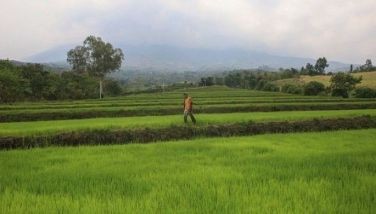Rice prices surge to P56 per kilo

MANILA, Philippines — The Department of Agriculture (DA) said it is probing manipulation or hoarding that has jacked up rice prices that have reached P56 per kilo in the market.
DA deputy spokesman Rex Estoperez said the government is monitoring and taking steps to stabilize rice prices.
“If rice prices right now are reaching P56 (per kilo), that’s not right. We will import if needed. This is what we do to stabilize (prices),” Estoperez said in Filipino.
He said the DA can task its Inspectorate and Enforcement Office to conduct monitoring even if the National Food Authority (NFA) has lost its regulatory powers.
“Someone is saying there is stockpiling of palay and rice; that will be our focus. Even if the NFA has lost its regulatory function, we will ask the Inspectorate and Enforcement Office to grant visiting powers to see if someone really is manipulating (prices) or hoarding,” Estoperez said in an interview on radio dwPM.
He said they are verifying reports that boatloads of rice were imported into the country, and that some traders were overpricing their stocks.
Still, Estoperez noted that rice prices have been affected, as the harvest season is over and won’t begin again until October.
Prices of imported rice have also increased, particularly in Vietnam, that has also led to price increases.
Estoperez said some traders are playing with the prices, offering as low as P38 per kilo for very limited quantities, and that is affecting the price structure.
“It’s ruining the price structure. They’re selling in low quantities and raising prices. People are panic buying,” he added.
The DA official said the department is willing to help out private traders and retailers if they need assistance in logistics.
Estoperez also called for the review of the Rice Tariffication Law, but noted that they are still awaiting data from the private sector in terms of buffer stocks to ensure that the country has enough rice.
He noted that the NFA only has nine days of buffer stock, while the rest of the 81 days should be shouldered by the private sector.
“If it’s less than 81 days with the private sector, there will be trouble and our national inventory will be lacking. That’s what we need to address,” he said.
No manipulation
Rice traders in the Intercity Industrial Estate and Golden City Business Park – two of the country’s major rice trading centers – have denied allegations by some quarters that they are involved in rice price manipulations.
Rice stakeholders claimed that the Bureau of Internal Revenue has started conducting revenue inspections on rice traders in the two major rice trading centers, but wondered why the inspections are being conducted when rice and palay stocks are currently thin and business is on a slump.
A text message in Filipino forwarded to The STAR states, “They (BIR) said issued receipts must have the buyer’s address… the penalty would be P5k per receipt.”
On the other hand, Malou Tolentino, Bulacan coordinator of the Philippine Rice Industry Stakeholders Movement, confided that many wholesale rice traders in Bulacan are thinking of temporarily shutting down their business due to the high cost of palay that translates to the rising prices of rice.
Meanwhile, rice trader Tony Santos said that the country is now currently at the peak of the “rice lean months” wherein stocks of the grain are thinly spread throughout the country.
He cited that rice prices usually increase during these times, as palay traders and rice traders have thin volume stocks of the staple grains, and prices follow the law of supply and demand.
Santos explained that the law of supply and demand states that prices are determined on the volume and supply of a product, wherein if the supply of a good or service outstrips the demand for it, prices will fall. If demand exceeds supply, prices will rise.
Citing reports from some quarters that rice traders manipulated the spike in rice prices, Santos urged these sectors to first assess the meaning of rice lean months; assess if the NFA or what government agency has enough rice buffer stocks for the country’s rice lean months; the effect in the increase of fuel prices and the rising dollar-peso exchange rate.
“What really happened is that rice prices in the world market increased,” Santos said in Filipino.
On the other hand, Rosendo So, president of the Samahang Industriya ng Agrikultura (SINAG), in a telephone interview, denied there is a rice cartel.
Just like Santos, So said the country is at the peak of the rice lean months and the DA can conduct inspections on rice/palay warehouses.
The inspections can only show thinly stocked volumes of rice/palay, he said.
So added that based on their monitoring, rice farmers engaged in a three-cycle crop season are currently harvesting their rice crops like in Pangasinan.
Farmgate price of fresh palay is pegged at P25 per kilo and farmgate price of clean and dry palay at P30 per kilo, he said.
However, So noted the bulk of the country’s rice harvests is expected to take place in October, and farmgate prices of fresh palay is expected to go down to P23 per kilo and clean and dry palay to P28 per kilo.
At these price ranges, production cost of rice would translate to P2,146 per 50-kilo sack or P42.93 per kilo. Plus, the mark-up price of retailers will cost less than P50 per kilo.
Currently, imported Vietnam rice is being sold in the local market at P2,500 per 50-kilo sack or P50 per kilo, while imported Thailand rice is being sold in the local market at P2,600 per 50-kilo sack or P52 per kilo.
That’s why rice importers have only orders until October, since these will have stiff competition from locally produced rice that is cheaper compared to imported rice.
- Latest
- Trending





























